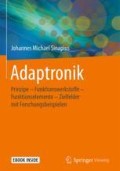Übersicht
Dieses Kapitel zeigt unterschiedliche Bauweisen aktiver Funktionselemente auf. Zwei Abschnitte gehen dazu zunächst auf Piezokomposite ein. Der zweite Abschnitt stellt stellwegvergrößernde Wandler vor. Anschließend werden Bauweisen für Sensorik und Aktorik aus den weiteren im vorangegangenen Kapitel beschriebenen Funktionswerkstoffen vorgestellt. Abschließend geben Arbeiten zu radial-sensorischen PVDF-Fasern einen Einblick in aktuelle Forschung für adaptronische Funktionselemente.
Warum die Menschen so wenig behalten können was sie lesen ist, daß sie so wenig selbst denken.
Georg Christoph Lichtenberg (1742–1799)
Access this chapter
Tax calculation will be finalised at checkout
Purchases are for personal use only
Notes
- 1.
benannt nach Jakob I. Bernoulli, 1654–1705, Schweizer Mathematiker und Physiker
Literatur
E. K. Akdogan, M. Allahverdi, A. Safari, Piezoelectric composites for sensor and actuator applications. IEEE T. Ultrason. Ferr. Freq. Cont. 52(5), 746–775 (2005)
D. Balageas, C.-P. Fritzen, A. Güemes (Hrsg.), Structural Health Monitoring (Wiley-ISTE, London, UK, 2006)
W. Bauhofer, J. Z. Kovacs, A review and analysis of electrical percolation in carbon nanotube polymer composites. Compos. Sci. Technol. 69(10), 203–205 (2009)
J. Bergman, J. McFee, G. Crane, Pyroelectricity and optical second harmonic generation in polyvinylidene fluoride films. Appl. Phys. Lett. 18(5), 203–205 (1971)
I. Bronstein, K. Semendjajew, Taschenbuch der Mathematik (Verlag Harri Deutsch, Thun, Schweiz, 1979)
F. Capri, D. De Rossi, Contractile folded dielectric elastomer actuators. In Proc. SPIE 6524, Electroactive Polymer Actuators and Devices (EAPAD) (2007)
CEDRAT Technoligies, www.cedrat-technologies.com. APA100M and APA40SM, Tables of Standard Properties of Use and Measurement (2017)
C. R. Farrar, K. Worden, Structural Health Monitoring: A Machine Learning Perspective (John Wiley & Sons, New Jersey, USA, 2012)
B. Glauß, B. Mohr, G. Seide, T. Gries, Multicomponent filaments process for the use as sensors. In The Fiber Society Spring Conference 2016: Textile Innovations Opportunities and Challenges (2016)
B. Glauß, W. Steinmann, S. Walter, M. Beckers, G. Seide, T. Gries, G. Roth, Spinnability and characteristics of polyvinylidene fluoride(PVDF)-based Bi-component fibers with a carbon-nanotube(CNT)-modified polypropylene core for piezoelectric applications. Materials 6(7), 2642–2661 (2013)
T. Gries, D. Veit, Technische Textilien – Vorlesungsskript (Institut für Textiltechnik der RWTH Aachen, Aachen, 2007)
T. Hoffstadt, D. Tepel, J. Maas, Automated roll-to-roll process for the fabrication. In Proceedings of EuroEAP, Bd. 3 (2013)
G. Kovacs, L. Düring, Contractive tension force stack actuator based on soft dielectric EAP. In Proc. SPIE 7287, Electroactive Polymer Actuators and Devices (EAPAD) (2009)
F. Lalande, Z. Chaudhry, C. Rogers, A simplified geometrically nonlinear approach to the analysis of the moonie actuator. IEEE T. Ultrason. Ferr. Freq. Cont. 42(1), 21–27 (1995)
R. Lammering, U. Gabbert, M. Sinapius, T. Schuster, P. Wierach (Hrsg.), Lamb-Wave Based Structural Health Monitoring in Polymer Composites (Springer, Cham, Schweiz 2018)
A. Lund, B. Hagström, Melt spinning of poly(vinylidene fluoride) fibers and the influence of spinning parameters on β-phase crystallinity. J. Appl. Polym. Sci. 116(5), 2685–2693 (2010)
A. Lund, B. Hagström, Melt spinning of β-phase poly(vinylidene fluoride) yarns with and without a conductive core. J. Appl. Polym. Sci. 120(2), 1080–1089 (2011)
K. Nakamura, Y. Wada, Piezoelectricity, pyroelectricity, and the electrostriction constant of poly(vinylidene fluoride). J. Polym. Sci. Part A-2 9(1), 161–173 (1971)
H. S. Nalwa (Hrsg.), Ferroelectric Polymers (Marcel Dekker, Inc, New York, USA 1995)
R. Newnham, D. Skinner, L. Cross. Connectivity and piezoelectric-pyroelectric composites. Mater. Res. Bull. 13(5), 525–536 (1978)
Physik Instrumente (PI) GmbH, www.piceramic.de/de. PI-Datenblatt-P-876-20150123 (2014)
Physik Instrumente (PI) GmbH, www.piceramic.de/de. PI-Datenblatt-P-878-20150123 (2014)
Physik Instrumente (PI) GmbH, www.piceramic.de/de. PL112 PL140 – Vollkeramische Biegeaktoren mit großem Hub (2017)
K. S. Ramadan, S. Sameoto, S. Evoy, A review of piezoelectric polymers as functional materials for electromechanical transducers. Smart Mater. Struct. 23(3), 033001 (2014)
D. Schawaller, F. Effenberger, Herstellung neuartiger piezoelektrischer Verbundmaterialien. Technical Report AiF-Abschlussbericht 14716 N/1, Denkendorf, Institut für Textilchemie und Chemiefaser (2008)
N. Schedukat, T. Gries, Schmelzspinnen von PVDF-Multifilamenten für neue Anwendungen. In 45th Dornbirn Man-Made Fibers Congress (2006)
G. Seide, S. Walter, W. Steinmann, T. Gries, Piezoelektrische Fasersensorik auf Basis von schmelzgesponnenen PVDF-Filamenten: Grenzen und Möglichkeiten. In Zweites bundesweites Arbeitskreis-Treffen AK Sensorisierung von Verbundwerkstoffen (Berlin, 2010)
Smart Material GmbH, www.smart-material.com/. MFC-V2.3-Web-full-brochure (2017).
W. Steinmann, Elektrisch leitfähige Polymerfasern aus Nanoverbundwerkstoffen. Dissertation, Rheinisch-Westfälische Technische Hochschule Aachen, 2014
D. Tepela, T. Hoffstadt, J. Maas, Automated manufacturing process for DEAP stack-actuators. In Proc. of SPIE 9056, Electroactive Polymer Actuators and Devices (EAPAD) (2014)
S. Walter, N. Schedukat, S. Houis, T. Gries, PVDF Multifilament Yarns: Production, Processing and Applications. In 47th Dornbirn Man-Made Fibers Congress (2008)
S. Walter, W. Steinmann, T. Gries, G. Seide, N. Schedukat, G. Roth, Melt-spun Polyvinyli-Dene-Fluoride fibers of textile fineness production, pro-cessing and properties. Chem. Fibers Int. (26), 49–50 (2010)
S. Walter, W. Steinmann, J. Schütte, G. Seide, T. Gries, G. Roth, P. Wierach, M. Sinapius, Characterisation of piezoelectric PVDF monofilaments. Mater. Technol.: Adv. Perform. Mater. 26(3), 140–145 (2011)
S. E. G. Walter, Entwicklung piezoelektrisch wirksamer Sensorfasern auf Basis von Polyvinylidenfluorid. Dissertation, Rheinisch-Westfälischen Technischen Hochschule Aachen, 2012
T. Wang, J. Herbert, A. Glass (Hrsg.), The Application of Ferroelectric Polymers (Blackie, Glasgow, 1988)
P. Wierach, Entwicklung von Piezokompositen für adaptive Systeme. Dissertation, Technische Universität Carolo-Wilhelmina zu Braunschweig, 2009
W. K. Wilkie, R. G. Bryant, J. W. High, R. L. Fox, R. F. Hellbaum, A. Jalink, B. D. Little, P. H. Mirick, Low-Cost Piezocomposite Actuator for Structural Control Applications. SPIE (2000)
Y. Zhang, Encyclopedia of Structural Health Monitoring, Kapitel Piezoelectric Paint Sensors for Ultrasonics-based Damage Detection. (Wiley, New Jersey, USA, 2009)
Author information
Authors and Affiliations
Corresponding author
Rights and permissions
Copyright information
© 2018 Springer-Verlag GmbH Deutschland, ein Teil von Springer Nature
About this chapter
Cite this chapter
Sinapius, J.M., Gries, T. (2018). Adaptronische Funktionselemente. In: Adaptronik. Springer Vieweg, Berlin, Heidelberg. https://doi.org/10.1007/978-3-662-55884-3_4
Download citation
DOI: https://doi.org/10.1007/978-3-662-55884-3_4
Published:
Publisher Name: Springer Vieweg, Berlin, Heidelberg
Print ISBN: 978-3-662-55883-6
Online ISBN: 978-3-662-55884-3
eBook Packages: Computer Science and Engineering (German Language)

